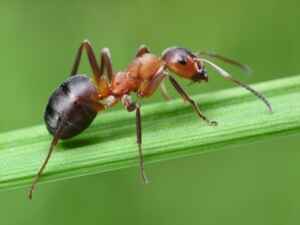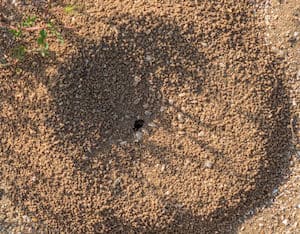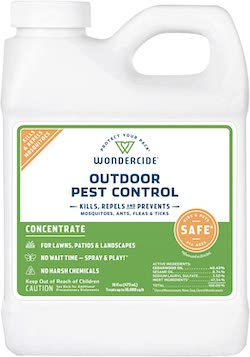The Real Reason Anthills Keep Popping Up In Your Yard
When it comes to maintaining your lawn’s lush, green appearance, unsightly objects like anthills can serve as a major frustration. So, I did some research to get to the bottom of why ants are so determined to build in beautiful yards.
So, why does my lawn have so many anthills? Like many other creatures, ants are after three things: food, water, and shelter. If your lawn has those three things readily available, ants will likely choose to nest there, resulting in unsightly anthills throughout your landscape.
No matter how obsessive you are about your lawn, once ants decide to take over, it takes the right methods and approach to get rid of them. Anthills pose a threat to your lawn’s appearance and your home’s overall curb appeal. The mounds of granular dirt often appear in sidewalk cracks, around the foundation of your home or patio, as well as along fence rows where the ants are protected against mower, weed eater and foot traffic. Luckily, there are plenty of ways to rid your yard of the unattractive mounds.

Why Ants Choose Your Yard
Like all living creatures, ants have a few basic requirements for life. Proximity to food and water as well as the ability to reproduce, are the quintessential things ants are looking for when scoping areas to build a nest. If your home has what they need, soon your yard will be letting you know in the form of anthills.
These dirt mounds can vary vastly in size and are a surefire way of knowing you have an ant problem. The mounds are simply made up of granulated dirt that has been brought up to the surface as a result of the nest being dug out below ground. Left unchecked, these anthills can become impressively large. However, it takes a consistent, perfect environment for anthills to become massive.
If your home has leaking pipes, poorly drained areas such as puddles or birdbaths, or any other constant, reliable water source, ants will take notice and leave a scent behind to attract other ants to it. This results in many ants coming to your home to see what it has to offer.
Food sources can be found in the form of trash bags, spilled food, or even litter in the yard. It can be as simple as discarded food on the ground or an outside table. How many times have you walked down the sidewalk and seen a pile of ants surrounding a tiny morsel of food? It does not take much to feed an entire colony of ants.
So long as ants have what they need to survive, they will scope out the area to build a nest and begin digging. Ant nests are intricate and bury deep into the earth. They often feature multiple entrances and exits with tunnels spanning the distance in between. In theory, all the anthills in your yard could be connected and a result of the same colony of ants.
The best way to prevent the physical signs of ants is by simply raking out the anthill as it forms. If you are not worried about the presence of the ants, this is very effective in keeping the hills from becoming too large and hardening over time. If you are mowing frequently, there is a good chance you are breaking up the hills with your mower blades without even knowing it.
Though a small, loosely compacted anthill does not pose a serious threat to your mower, the dirt will dull the blades much quicker than ordinary grass mowing. However, fully formed, hardened anthills can pose a more serious threat to mowers and should be dealt with before they are mowed over.

How to Eradicate Anthills
Physically speaking, it is not very hard to get rid of an anthill. If the mound has been fairly recently constructed, it could be as simple as knocking it down with a rake or sweeping it away with a broom. If hardened and more mature, it may take a shovel and a little more elbow grease to eliminate the structure.
The problem lies in the fact that once you get rid of the physical evidence, it will likely reappear due to the ants tunneling further into the earth and depositing more dirt at the surface. The true way to eradicate anthills in your yard is by eradicating the ants themselves.
Other Physical Threats Ants Pose
Carpenter ants earned their moniker for a reason. They love wood. They both nest in it and eat it. Though an anthill is not going to signify a carpenter ant infestation, there are other telltale signs. Other ant species can cause structural damage to homes due to digging beneath foundations and nesting in and chewing home components and should be taken seriously.
How to Deter Ants
To put it simply, all you have to do to eliminate ants is to first eliminate the things that attracted them to your yard in the first place. Being disciplined about emptying excess water from potted plants, fixing leaking spigots, and pouring out items that collect water is an effective way to eradicate the water source.
Ridding your home of ant food can be difficult but is possible. Ants are attracted to nearly any food a human consumes, so any food waste is perfect for an ant. Moving trash cans away from the home as well as picking up any litter surrounding your home can keep the ants further from the home, but not necessarily keep them from nesting in the yard.
The biggest issue in deterring ants lies in the fact that ants need the same things humans need. As long as you are producing food waste and using water, ants will be there to get what they can. The goal is to be as responsible with your disposal of food waste and control of water around your home, to make your home as undesirable as possible to a colony of ants.
How to Eliminate Stubborn, Established Ant Colonies
When removing food and water sources just is not enough, it may be necessary to try introducing elements that would further deter the pests from setting up residence. There are plenty of natural and chemical means of deterring ants that are both effective and safe if used properly. These products can help you reclaim your territory and give you back the lush, green lawn you worked so hard for.
Natural Means of Ant Prevention
There are many items that humans love and use every day that ants are not so fond of. Food items such as mint, vinegar, pepper, and lemon juice, are all effective in deterring ants when used properly. It often takes a very disciplined approach when using natural methods, as the means are centered around deterring the ants rather than eliminating the population. Once the items that are deterring cease to exist, the ants will often find their way back to the nest.
Chemical Means of Ant Prevention
Sometimes, it takes a more serious approach to eliminate an ant colony. Boric acid can be highly effective in killing the entire colony of ants. When mixed with a desirable food source, ants will partake in the food as well as bring it back to the nest, which eventually poisons the entirety of the colony. When poisonous products are used, it is imperative to pay attention to the manufacturer’s instructions for safe use.
Professional Prevention of Ants
The most effective and safe way to eliminate ants around the interior and exterior of your home is to call a pest control professional. The experience and know-how that a pest control specialist has paired with the right products and tools is a deadly combination guaranteed to get the job done. Before you contact a pest control specialist, consider how rain affects pest control.
Related Questions
What Other Threats Do Ants Pose? Ants are destructive. They pose a great threat to the areas in which they reside. Crops, plants, and structures are all at risk of damage due to a thriving ant population. Ants are also harmful to people as they often aggressively bite and sting. While most people will only experience a momentary pain, ants can cause anaphylactic shock in others and should be taken seriously.
What Types of Ants Do I Have? There are hundreds of species of ants. However, only 25 species make a habit of infesting homes. The most generally concerning ant in the yard is the fire ant, due to its ability to repeatedly inflict stings and bites. When dealing with anthills, especially in the case of red ants, wearing protective footwear and clothing is advised.
Do Ants Attract Other Bugs? Ants have been known to “farm” other pests. Aphids and Mealybugs will often show up once an ant colony is established and cause damage to plants and crops as a result. The ants “farm” the aphids and mealybugs in the sense that they protect the population, much like a farmer protects his livestock. They even go as far as to aid and assist the pests in survival. The relationship is symbiotic, as the aphids and mealybugs secrete honeydew, a delicacy for ants.
Thank you for reading! You can find more great lawn tips here.



